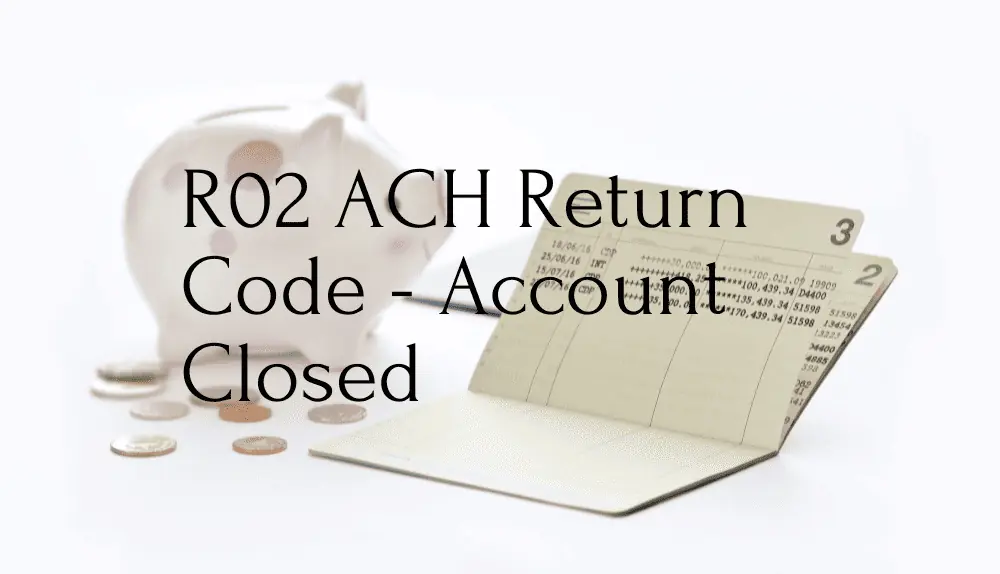In the ever-evolving landscape of financial transactions, understanding the intricacies of electronic payments has become paramount for businesses and individuals alike. Among the myriad of codes and terminologies that govern these transactions, one stands out with particular significance – the enigmatic R02 ACH Return Code.
Like a secret door leading to a world of hidden meanings, this return code has the power to unlock a trove of insights into the world of Automated Clearing House (ACH) payments. In this article, we embark on a journey to demystify this code, delving into its implications, causes, and remedies, all while unraveling the fascinating tapestry of electronic fund transfers. So, fasten your seatbelts and prepare to explore the labyrinthine realm of the R02 ACH Return Code, where every piece of knowledge brings us one step closer to mastering the art of seamless financial transactions.
What Does R02 ACH Return Code Mean?
ACH Return Code R02 signifies that a transaction initiated through the Automated Clearing House (ACH) network has been returned due to “Account Closed.” In simpler terms, the funds could not be transferred because the bank account involved in the transaction has been closed by the account holder. This return code is an essential part of the ACH system, which handles electronic funds transfers between financial institutions across the United States.

When an ACH payment is attempted, the receiving bank checks the account’s status to ensure it is active and valid. If the account is found to be closed, the transaction cannot proceed, and the bank returns the payment to the originating institution with the R02 code attached. This code serves as a notification to the initiator that the payment was unsuccessful due to the closure of the account.
Several reasons might lead to an account being closed, such as the account holder choosing to terminate the account voluntarily, the bank closing the account due to insufficient funds or suspicious activities, or the account becoming inactive for an extended period.
Understanding ACH Return Code R02 is crucial for businesses and individuals engaged in electronic transactions. In case of an R02 return, the initiator should promptly reach out to the intended recipient to rectify the situation and ensure successful future transactions. Additionally, recipients are advised to verify account information before initiating any ACH payment to prevent potential issues with closed accounts.
Reasons R02 ACH Return Code Occurs
The ACH R02 return code, indicating that a transaction could not be processed due to “Account Closed,” can occur for various reasons related to the status of the recipient’s bank account. Understanding these reasons is vital for both the originators and recipients of ACH payments to navigate the complexities of electronic fund transfers successfully. Here are some common reasons why an ACH R02 return code may occur:
Voluntary Account Closure
The most straightforward reason for an R02 return code is when the account holder intentionally closes their bank account. This might happen due to a change in financial institutions, moving to a different account type, or simply deciding to terminate the account.
Insufficient Funds
If the account has insufficient funds at the time the ACH transaction is attempted, the bank may close the account and return the payment with an R02 code. This often happens when a customer repeatedly overdraws their account without rectifying the negative balance.
Fraud or Suspicious Activity
To protect the account holder and prevent potential fraud, banks may close accounts that have been compromised or involved in suspicious activities. In such cases, the ACH transaction will be rejected with an R02 code.
Account Holder’s Death
In the unfortunate event of the account holder’s passing, their account may be closed by the bank or the account executor, resulting in an R02 return for any incoming ACH transactions.
Inactive Accounts
An account that remains dormant or inactive for an extended period may be closed by the bank. If an ACH payment is attempted after the account closure, it will be returned with an R02 code.
Mismatched Account Information
Sometimes, account information provided by the originator of the ACH transaction may contain errors or inaccuracies. If the account number or routing number does not match the recipient’s bank records, the transaction will fail and trigger an R02 return code.
Frozen Accounts
Accounts that are frozen due to legal actions, court orders, or unresolved disputes may not be eligible to receive ACH transactions, leading to an R02 return.
Technical Glitches
Occasionally, technical issues within the ACH system or between financial institutions can cause the rejection of an otherwise valid ACH transaction, resulting in an R02 return code.
To mitigate the occurrence of ACH R02 return codes, originators of ACH transactions should ensure they have accurate and up-to-date account information for recipients. Prior verification of account details can help avoid mishaps and reduce the chances of encountering return codes.
For recipients, it is essential to monitor their accounts regularly, address potential issues promptly, and inform relevant parties if any changes to account status or ownership are anticipated. Swift communication between originators and recipients can help rectify rejected payments and facilitate successful ACH transactions in the future.
Solutions to Fix R02 ACH Return Code
Fixing the ACH R02 return code, which indicates a failed transaction due to “Account Closed,” requires careful attention to detail and proactive measures from both the originator and recipient of the ACH payment. By implementing appropriate solutions, businesses and individuals can reduce the likelihood of encountering R02 return codes and ensure successful electronic fund transfers. Here are some key solutions to address and prevent ACH R02 return codes:

Verify Account Information
Before initiating any ACH transaction, originators must double-check the accuracy of the recipient’s account information, including the account number and routing number. Utilizing validated and up-to-date account details reduces the chances of encountering return codes caused by mismatched or erroneous information.
Communicate with Recipients
Open lines of communication between originators and recipients are essential. If a payment is scheduled, the recipient should be informed in advance to ensure the account is active and has sufficient funds. If there are any potential issues or changes in account status, recipients should promptly notify the originator to avoid unnecessary return codes.
Use ACH Block Filters
Banks and financial institutions can employ ACH block filters to protect accounts from unauthorized ACH transactions. These filters can identify and block potentially fraudulent or suspicious transactions, reducing the risk of encountering an R02 return code due to account closure related to fraud.
Monitor Account Activity
Both originators and recipients should regularly monitor their accounts to detect any unusual activity. Early identification of potential problems, such as insufficient funds or suspicious transactions, can prevent accounts from being closed and ACH transactions from being rejected.
Handle Inactive Accounts
Recipients with accounts that may become inactive should take proactive steps to keep their accounts active. Making small transactions or logging into online banking periodically can help prevent account closure due to inactivity.
Resolve Overdrafts
If an ACH payment is rejected due to insufficient funds, originators should work with the recipient to resolve the overdraft promptly. Once the account is in good standing, the ACH transaction can be re-initiated successfully.
Update Account Information
Recipients should inform originators of any changes to their account information, such as a new account number or updated routing number. Keeping the originator informed ensures that future ACH transactions will be directed to the correct account.
Educate Staff and Customers
Businesses that frequently initiate ACH payments should educate their staff about the importance of accurate account information and the potential consequences of ACH R02 return codes. Similarly, financial institutions can educate their customers about the implications of account closure and how to maintain active accounts.
Resolve Account Holder’s Passing
In case of an account holder’s death, proper procedures should be followed to close the account legally. If the account needs to remain open for estate-related matters, the executor or legal representative should communicate the necessary information to the relevant parties.
Automate Payment Reconciliation
Utilizing automated payment reconciliation systems can help identify failed ACH transactions and resolve return codes efficiently. These systems can also provide valuable insights into potential issues and help streamline the payment process.
By adopting these solutions, both originators and recipients can significantly reduce the occurrence of ACH R02 return codes and enhance the efficiency and reliability of ACH transactions. It is essential to be proactive, vigilant, and communicative in managing ACH payments to ensure seamless financial transactions within the ACH network.
How Financial Institutions Can Help Customers Avoid R02 Return Code?
Financial institutions play a crucial role in helping customers avoid ACH R02 return codes, which occur when ACH transactions fail due to “Account Closed.” Here are ways they can assist:
Educate Customers
Financial institutions can educate their customers about the importance of maintaining active accounts and the potential consequences of account closure. Providing information on how ACH transactions work and the significance of accurate account information can empower customers to avoid return codes.
Account Monitoring
Implementing account monitoring systems allows financial institutions to alert customers about potential issues, such as low balances or account inactivity. Early notifications help customers take corrective actions before encountering ACH R02 return codes.
Transaction Limits
Offering transaction limit options enables customers to set appropriate caps on ACH transactions, preventing overdrafts and insufficient funds situations.
Transaction Verification
Banks can add an extra layer of security by verifying ACH transactions with customers through notifications or confirmation messages. This step ensures that customers are aware of outgoing transactions and can address potential errors promptly.
Automated Alerts
By offering automated alerts for account activities, financial institutions enable customers to receive real-time notifications about ACH transactions, keeping them informed and vigilant.
Online Banking Tools
Providing user-friendly online banking tools enables customers to manage their accounts efficiently, verify account details, and update information easily, reducing the risk of mismatched account data.
Through proactive communication, advanced technologies, and enhanced security measures, financial institutions can empower their customers to navigate the ACH landscape with confidence and minimize the occurrence of ACH R02 return codes.
Conclusion
In conclusion, understanding and addressing the ACH R02 return code, signifying a failed transaction due to “Account Closed,” is essential for businesses, individuals, and financial institutions involved in electronic fund transfers. By implementing preventive measures, such as verifying recipient account information, maintaining open communication, monitoring account activity, and promptly resolving issues, ACH R02 return codes can be significantly reduced.
Financial institutions can play a crucial role in helping customers avoid these return codes by providing education, advanced account monitoring, transaction limits, verification measures, and automated alerts. With proactive efforts and vigilant practices, the ACH system can become a seamless and reliable platform, fostering smooth and efficient electronic payment experiences for all stakeholders.
Frequently Asked Questions (FAQs)
How can businesses prevent ACH R02 Return Codes?
Businesses can prevent R02 return codes by verifying recipient account details, maintaining communication with recipients, monitoring account activity, resolving overdrafts, keeping accounts active, and updating account information promptly.
Can an ACH R02 Return Code be fixed?
Yes, in most cases, an ACH R02 Return Code can be fixed. Originators should work with recipients to address the underlying issue that caused the code, such as updating account information or resolving insufficient funds.
What should recipients do if they receive an ACH R02 Return Code?
Recipients should review the reason for the return code, such as account closure or insufficient funds. They should promptly communicate with the originator to resolve the issue and provide accurate account information if necessary.
Is there a way to prevent ACH R02 Return Codes due to insufficient funds?
Yes, to prevent insufficient funds-related return codes, recipients should ensure their accounts have sufficient funds before ACH transactions and monitor their account balances regularly.
Can technical issues cause ACH R02 Return Codes?
Yes, technical glitches within the ACH system or between financial institutions can occasionally lead to ACH R02 Return Codes. However, these issues are usually temporary and can be resolved by reinitiating the transaction.

